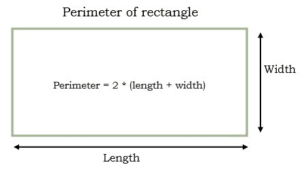Back to: Mathematics Primary 6
HELLO, WELCOME BACK TO CLASS
Perimeter is the total distance round an object.
A rectangle has four sides. Made up of two long sides called length and two shorter sides called breadth or width. The two lengths are equal and opposite same with the two widths.

Perimeter(P)= L + L +B +B
P = 2L + 2B
P = 2(L +B)
Area is the total surface of a shape or an object.
We know that the area of the rectangle is given by
Area = length × breadth
A = a × b square units
Length of the rectangle = Area
breadth
Breadth of the rectangle = Area
length
Worked-out problems on Perimeter and Area of Rectangle:
- Find the perimeter and area of the rectangle of length 17 cm and breadth 13 cm.
Solution:
Given: length = 17 cm, breadth = 13 cm
Perimeter of rectangle = 2 (L + B)
= 2 (17 + 13) cm
= 2 × 30 cm
= 60 cm
Area of rectangle = length × breadth
= (17 × 13) cm2
= 221 cm2
- Find the breadth of the rectangular plot of land whose area is 660 m2 and whose length is 33 m. Find its perimeter.
Solution:
We know that the breadth of the rectangular plot = Area/length = 660m/33m = 20 m
Therefore, the perimeter of the rectangular plot = 2 (L + B) = 2(33 + 20) m = 2 × 53 m = 106 m
EVALUATION
- Find the area of the rectangle if its perimeter is 48 cm and its breadth is 6 cm.
- Find the breadth and perimeter of the rectangle if its area is 96 cm22 and the length is 12 cm.
- A wire in the shape of rectangle of length 25 cm and breadth 17 cm is rebent to form a square. What will be the measure of each side?
- How many envelopes can be made out of a sheet of paper 100 cm by 75 cm, supposing 1 envelope requires 20 cm by 5 cm piece of paper?
- A floor of the room 8 m long and 6 m wide is to be covered by square tiles. If each square tile is 0.8 m, find the number of tiles required to cover the floor. Also, find the cost of tiling at the rate of #7 per tile.
